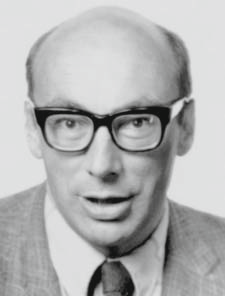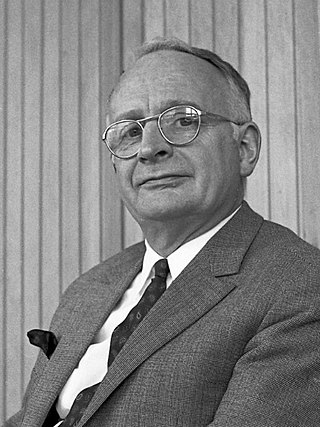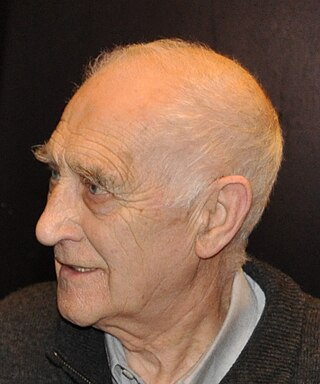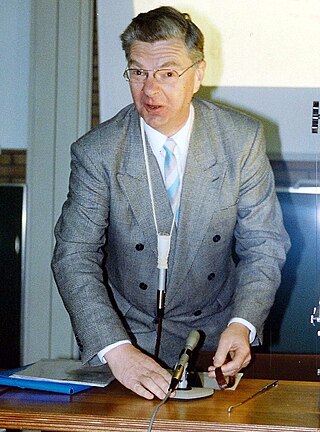Related Research Articles

Peter John Landin was a British computer scientist. He was one of the first to realise that the lambda calculus could be used to model a programming language, an insight that is essential to the development of both functional programming and denotational semantics.

Adriaan "Aad" van Wijngaarden was a Dutch mathematician and computer scientist. Trained as a mechanical engineer, Van Wijngaarden emphasized and promoted the mathematical aspects of computing, first in numerical analysis, then in programming languages and finally in design principles of such languages.
ALGOL Y was the name given to a speculated successor for the ALGOL 60 programming language that incorporated some radical features that were rejected for ALGOL 68 and ALGOL X. ALGOL Y was intended to be a "radical reconstruction" of ALGOL.

Nobuo Yoneda was a Japanese mathematician and computer scientist.
Eric "Rick" C. R. Hehner is a Canadian computer scientist. He was born in Ottawa. He studied mathematics and physics at Carleton University, graduating with a Bachelor of Science (B.Sc.) in 1969. He studied computer science at the University of Toronto, graduating with a Master of Science (M.Sc.) in 1970, and a Doctor of Philosophy (Ph.D.) in 1974. He then joined the faculty there, becoming a full professor in 1983. He became the Bell University Chair in software engineering in 2001, and retired in 2012.
John Edward Lancelot Peck was the first permanent Head of Department of Computer Science at the University of British Columbia (UBC). He remained the Head of Department from 1969 to 1977.
Barry James Mailloux obtained his Master of Science (M.Sc.) in numerical analysis in 1963. From 1966, he studied at Amsterdam's Mathematisch Centrum under Adriaan van Wijngaarden, earning a Doctor of Philosophy (Ph.D.) in 1968.

Cornelis Hermanus Antonius "Kees" Koster was a Dutch computer scientist who was a professor in the Department of Informatics at the Radboud University Nijmegen in the Netherlands.
Richard Simpson Bird was an English computer scientist.
Lambert Guillaume Louis Théodore Meertens or L.G.L.T. Meertens is a Dutch computer scientist and professor. As of 2020, he is a researcher at the Kestrel Institute, a nonprofit computer science research center in Palo Alto's Stanford Research Park.
Thomas Stephen Edward Maibaum Fellow of the Royal Society of Arts (FRSA) is a computer scientist.

Willem Louis van der Poel is a Dutch computer scientist, who is known for designing one of the first computers to be designed in the Netherlands, the Zeer Eenvoudige Binaire Reken Automaat (ZEBRA), translated as Very Simple Binary Automatic Calculator.
Charles Hodgson Lindsey was a British computer scientist, most known for his involvement with the programming language ALGOL 68.
Klaus Samelson was a German mathematician, physicist, and computer pioneer in the area of programming language translation and push-pop stack algorithms for sequential formula translation on computers.
Eiiti Wada is a computer scientist and emeritus professor at the University of Tokyo and the Research Director of Internet Initiative Japan (IIJ), a computer network technology company. He is one of the creators of the Happy Hacking Keyboard.
IFIP Working Group 2.1 on Algorithmic Languages and Calculi is a working group of the International Federation for Information Processing (IFIP).
Charles Abraham Katz was an American mathematician and computer scientist known for his contributions to early compiler development in the 1950s.

Michel Sintzoff was a Belgian mathematician and computer scientist.
Joseph Henry Wegstein was an American computer scientist.
Yanhong Annie Liu is a computer scientist and professor of computer science at Stony Brook University where she works on new programming languages, software systems, algorithms, program design, optimizing, analysis, and transformations, intelligent systems, distributed computing systems, and computer security.
References
- ↑ Swierstra, Doaitse; Gibbons, Jeremy; Meertens, Lambert (2 March 2011). "ScopeEtc: IFIP21: Foswiki". Foswiki. Retrieved 13 October 2020.
- ↑ de Morgan, R. (July 1977). "The Algollers" (PDF). ALGOL Bulletin. 41: 8–9. Retrieved 11 October 2020– via Computer History Museum.
- ↑ Ross, Douglas T. (October 1966). "An Algorithmic Theory of Language (AB26.2.2)". Defense Technical Information Center. Massachusetts Institute of Technology. p. 6. Archived from the original on 26 June 2013. Retrieved 12 August 2020.
- ↑ Ross, D. T. (August 1967). "AB26.2.2 Features Essential for a Workable ALGOL X". ACM SIGPLAN Notices: ALGOL Bulletin. 26 (2). Association for Computing Machinery: Digital Library. doi:10.1145/1139498.1139500. S2CID 38156680 . Retrieved 12 August 2020.
- ↑ "Adriaan Van Wijngaarden" (PDF). Archived from the original (PDF) on 19 October 2013.